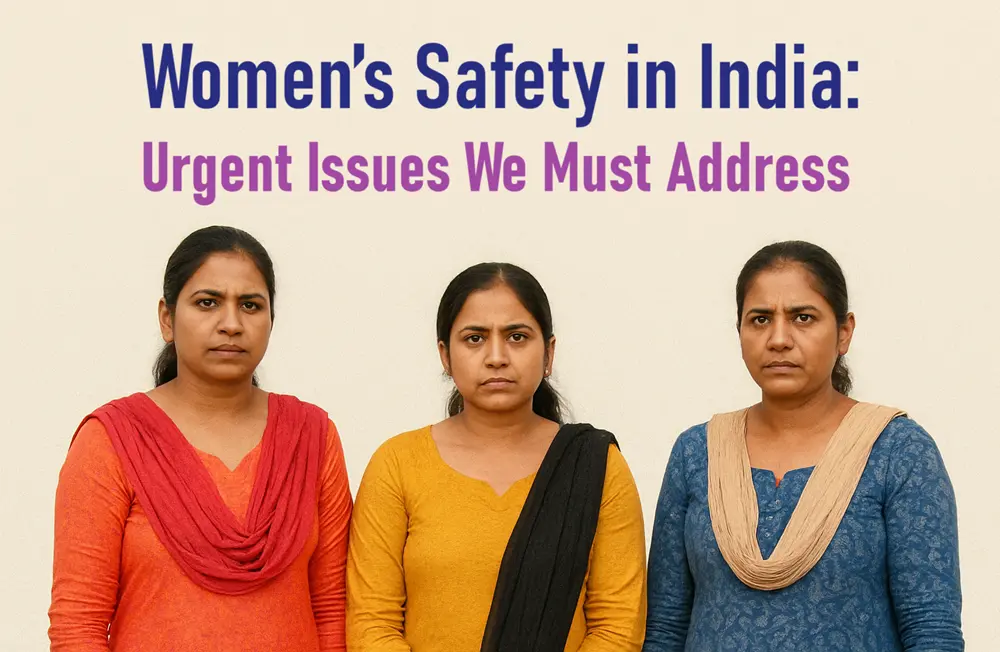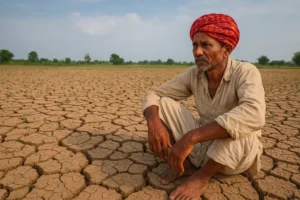Key Challenges of Women’s Safety in India
Women’s safety in India has always been a serious concern, and in 2025, it’s still at the heart of public debate. Every few weeks, news headlines remind us that the problem is far from over.
From crowded city streets to the vast digital world, threats can appear anywhere—often when least expected.
While laws have changed and technology has advanced, many old challenges remain, and new ones have emerged.
Domestic violence, cyber harassment, unsafe public spaces, and slow justice systems all play a role in making women feel vulnerable.
Understanding women’s safety issues in India is the first step toward real change.
So, let’s explore the key challenges women face today and what can be done to create a safer, more equal India for all.

Women’s Safety in India in 2025: What’s Really Going On—and What We Can Do About It
Women’s safety is a critical issue in India, and 2025 is no exception. High-profile incidents in multiple states keep pushing this to the top of search trends and dinner-table conversations. But beyond the headlines, what are the real, ground-level challenges today? What changed in the law recently? What’s working, what isn’t, and—most importantly—what can citizens and activists actually do next?
Discover the key challenges to women’s safety in India in 2025, from rising cybercrimes and domestic violence to legal transition issues and gaps in public safety. Learn about current laws, helplines, and actionable solutions for citizens and activists.
What are the top challenges to women’s safety in India in 2025? Quick Answer
- Under-reporting and uneven access to justice—especially outside big cities; high pendency of sexual-offence cases persists.
- Legal transition pains after India’s new criminal codes came into force in 2024—citizens and even institutions are still adapting.
- Domestic and intimate partner violence remain the largest share of recorded crimes against women; help-seeking is still hard.
- Cyber-enabled harassment and sextortion are rising fast, and they spread across states in organized ways.
- Safety in public spaces and transport is inconsistent; Safe City pilots help but are not yet universal.
- Workplace harassment (PoSH) compliance gaps—with the Supreme Court pushing fresh audits and the government tightening disclosure rules.
- Support systems exist (112 ERSS, One Stop Centres, 181 helpline) but awareness and last-mile delivery vary by district.
If you want the fuller story, let’s unpack each piece.
First, a reality check: what the data says
The latest official, consolidated crime statistics available nationally come from NCRB’s Crime in India 2022 and allied sources. They show:
- Crimes against women increased ~4% over 2021, with 4,45,256 cases in 2022. The rate rose to 66.4 per 100,000 women. The largest categories were cruelty by husband/relatives, kidnapping & abduction, and assault to outrage modesty.
- Delhi’s rate was the highest among major jurisdictions in 2022; Nagaland the lowest, reflecting strong state-level variation.
- Pendency remains a structural problem. In 2022, 89.2% of POCSO cases were awaiting trial in Fast-Track Special Courts—an indicator of broader criminal-justice delays that also affect adult survivors.
- Cyber harm is now mainstream. Government updates in 2024–25 highlight growing sextortion and investment-fraud ecosystems; I4C (the Indian Cyber Crime Coordination Centre) and state cyber cells are responding with large busts, but the threat remains networked and agile.
What this means in 2025: the pattern is steady—domestic abuse dominates recorded crime, public-space harassment persists, and cyber-enabled abuse is exploding. Meanwhile, case pendency and patchy local capacity slow justice.
What changed recently in the law—and why it matters now
From July 1, 2024, India replaced the IPC/CrPC/Evidence Act with three new codes:
- Bharatiya Nyaya Sanhita (BNS), 2023 – Substantive criminal law, including sexual offences (e.g., Section 63 defines rape).
- Bharatiya Nagarik Suraksha Sanhita (BNSS), 2023 – Procedure (investigation, arrest, trial timelines, etc.).
- Bharatiya Sakshya Adhiniyam (BSA), 2023 – Evidence rules.
Why this matters for women’s safety:
- Continuity + transition pain: The core protections continue, but police, prosecutors, defence counsel, and judges are simultaneously adapting to new section numbers, forms, and procedures. In the short term, that can create confusion and process delays—exactly where survivors already struggle.
- Opportunity: The codes aim to streamline procedure and evidence, which—if implemented well—can improve speed and quality of trials in sexual-offence and domestic-violence cases over time.
The seven biggest challenges we have to confront in 2025
Based on recent reports and expert surveys, here are some of the biggest challenges we must confront in 2025.
1) Under-reporting and access: the first mile is still the hardest
Even in 2025, filing the first report remains a barrier due to stigma, fear of retaliation, distance to a police station, or unfamiliarity with online options. Domestic violence and cruelty by husband/relatives continue to be the largest category of recorded offences; experts believe actual prevalence is higher than reported.
What helps today:
- 112 ERSS—a single, nationwide emergency number (call, app, SMS); it geotags and routes help fast.
- 181 Women Helpline—confidential advice and referrals.
- One Stop Centres (OSCs) in districts—integrated medical, legal, and counselling support for survivors.
2) Court pendency and uneven justice
Data show very high pendency in sexual-offence cases, including in dedicated Fast-Track Special Courts (FTSCs) for POCSO. The government reports big disposal numbers, but civil-society audits still find backlogs remain heavy—especially in populous districts.
Why this matters: Justice delayed is justice denied. Survivors face years of uncertainty, witness fatigue, and socio-economic pressure to withdraw.
3) Cyber-enabled harm: from trolling to sextortion
Harassment, doxxing, deepfakes, and sextortion now target women of all ages, including students and professionals. The I4C portal (cybercrime.gov.in) and joint police operations show organized networks behind many scams. Losses and complaints are rising, and sextortion overlaps with privacy violations and moral shaming—deterring victims from reporting.
What helps today:
- Report at cybercrime.gov.in (choose “Women/Child” category if relevant).
- Police cyber cells increasingly coordinate via I4C (training, analytics).
Read Here: Crime and Deviance in the Digital Age
4) Safety in public spaces and transport
CCTV grids, command-and-control centres, smart lighting, and SOS apps have expanded in cities under the Safe City projects (Nirbhaya Fund). But coverage is uneven and many towns aren’t yet on smart surveillance or safe-route design.
5) Workplace harassment: compliance on paper vs safety in reality
The PoSH Act (2013) requires Internal Committees and due process in every workplace. Yet non-compliance persists. In August 2025, the Supreme Court ordered a district-wise survey to assess PoSH compliance. Meanwhile, from July 14, 2025, companies must make detailed PoSH disclosures in Board reports—raising accountability. Still, many committees exist only on paper or lack training.
Read Here: The Hidden Cost of Stigma in Professional Spaces
6) Rural and small-town gaps
Urban pilots show promise, but safety infrastructure, counselling services, transport connectivity, shelters, and specialized police capacity often thin out beyond district HQs—worsening under-reporting and case follow-up.
7) Fragmented awareness of rights and remedies
People know “something” changed in the law but struggle with the how-to: Which section? Where to go? How to collect digital evidence? Survivors and allies need plain-language guides that connect 112/181/OSCs, PoSH, POCSO, and the new BNS/BNSS/BSA ecosystem.
What’s already in place (and worth using more)
- 112 Emergency Response Support System (ERSS): One number nationwide; supports calls, the 112 India app/SOS, and GIS-based dispatch. Save it and use it.
- 181 Women Helpline: 24×7, confidential; connects you to police, OSCs, shelters, and legal aid.
- One Stop Centres (Mission Shakti): Medical care, legal aid, counselling, shelter linkage—under one roof. Ask for the OSC at your district hospital or DPO office.
- Safe City pilots (Nirbhaya Fund): CCTVs, lighting, ICCCs, women-centric mobility upgrades—expanding but not universal yet.
- Fast-Track Special Courts (FTSCs): Dedicated courts for rape/POCSO; capacity expanding, but pendency remains a concern in many districts.
- National Cyber Crime Reporting Portal: Centralized reporting; escalating state action against sextortion and deepfake crimes.
The 2025 legal landscape: how to read the new codes (without jargon)
- BNS (substantive offences) retains prohibitions on sexual assault and rape—e.g., Section 63 (rape)—with penalties aligned to earlier reforms. The language is updated, but protections continue.
- BNSS (procedure) reshapes timelines, warrants, and trial processes intended to speed up cases; implementation quality will determine the actual impact.
- BSA (evidence) speaks to admissibility and digital evidence—key for cyber-offences and technology-facilitated abuse.
Bottom line: If you knew IPC/CrPC earlier, think of BNS/BNSS/BSA as the new “addresses” for offences and procedure. Lawyers and police are updating their playbooks; insist on your rights and ask your counsel to cite the new section numbers.
12 Practical actions citizens and activists can take right now
- Save these numbers and links:
- 112 (ERSS) for any emergency.
- 181 for women’s helpline support.
- cybercrime.gov.in to report harassment, sextortion, or deepfakes.
- Document everything early. For physical offences, seek immediate medical care and ask for sexual assault forensic exam; for cyber offences, save screenshots, URLs, headers before reporting.
- Ask for the district’s One Stop Centre (OSC) when you need integrated help—medical, legal, counselling.
- Push for PoSH compliance where you work. Ensure a trained Internal Committee, bilingual policies, and annual staff training. If your employer drags their feet, remind them that 2025 rules require detailed PoSH disclosures in the Board’s Report.
- Use Right to Information (RTI) and social audits to check your city’s Safe City components: streetlighting uptime, CCTV coverage, SOS buttons, ICCC response times.
- Demand safer routes to school and work. Ask local bodies for traffic calming, last-mile lighting, and CCTV at bus stops; these show up in municipal budgets—watch them.
- Build cyber-hygiene habits in families and colleges: privacy settings, two-factor authentication, secure backups, and no-forwarding of unverified content. Report sextortion immediately; do not pay.
- Track case progress. After an FIR, follow the case diary and court listing with your lawyer. If the case stalls, seek directions for speedy trial or transfer where appropriate.
- Push for survivor-centric systems in your district: private waiting areas in courts, video-conferencing for testimony, and trained prosecutors for sexual-offence trials.
- Volunteer where it matters: with OSCs, women’s shelters, legal-aid clinics, and school-level awareness programs (especially on POCSO and online safety).
- Support data transparency. Advocate that the state police publish monthly dashboards on crime against women, clearance rates, and cyber-complaints—not just annual NCRB figures.
- Amplify good practice. Share local wins—like districts improving CCTV grids or new POCSO-court infrastructure—so others copy what works.
What’s driving risk in 2025? Four structural forces to watch
- Digital proliferation without equal safety literacy. Smartphones + AI tools (deepfakes) + cheap data = new vectors of harm that outpace awareness—especially among teens and first-time internet users.
- Urbanization with patchy last-mile design. Where walkability, lighting, and surveillance are weak, fear and opportunistic crime rise. Safe City-style fixes help—but only if they cover everyday spaces (lanes, bus stands, campuses).
- Justice bottlenecks. High pendency saps trust, encourages intimidation, and deters reporting—especially for domestic violence and sexual crimes.
- Compliance vs culture in workplaces. Many organizations have PoSH on paper, but culture change lags. The Supreme Court’s 2025 direction and new disclosure rules can nudge real accountability, if enforced.
Are there signs of progress?
Yes—let’s give credit where it’s due:
- Emergency access is simpler than ever: 112 ERSS is nationwide and integrated.
- Institutional capacity is growing: FTSCs expanded across states; disposal numbers are significant even if pendency remains.
- Cyber response is more coordinated: I4C links state police, and large sextortion/fraud rings are being busted.
- Public-space design is improving in pilot cities through Safe City upgrades and ICCCs; more cities are building on these.
- Courts and regulators are pushing compliance: PoSH disclosures and SC monitoring can close chronic workplace gaps.
Progress is real, but coverage and consistency are the hurdles.
A citizen’s checklist: if something happens, what should I do?
- If you’re in danger: dial 112 or use the 112 India app; share your live location if possible.
- If it’s domestic violence: you can call 181 for confidential guidance, seek an OSC, and ask police about BNS sections applicable to bodily harm/sexual violence.
- If it’s online abuse/sextortion: do not pay; capture evidence (screenshots, links), file at cybercrime.gov.in, and inform local cyber cell.
- Medical aid & evidence: at a government hospital, request a forensic exam; you have the right to free immediate first-aid/medical treatment in sexual-offence cases.
- Legal help: ask the police or OSC for free legal aid and a protection order where needed.
- Follow-up: note FIR number, IO name, and the court case number; track hearings and ask for video-conference testimony if travel or safety is an issue.
Policy and systems: the five fixes that will move the needle fastest
- Guarantee time-bound investigations and trials for sexual offences. Track every district’s investigation, charge-sheet, and trial timelines on public dashboards; reward high performers and troubleshoot laggards.
- Scale Safe City elements to Tier-2/3 towns. Focus on lighting, CCTV, safe bus stops, and last-mile mobility; maintain them, don’t just install them.
- Mainstream cyber-safety in schools and colleges. Partner with I4C/state police for annual curriculum modules on reporting and evidence preservation; add counsellors trained for sextortion cases.
- Make PoSH real, not ritual. Enforce Board-level disclosures, conduct random audits, and penalize non-compliant employers; publish sector-wise compliance rates.
- Fund OSCs and shelters to standards. Each district should have 24×7 availability, trauma-informed counsellors, and safe transport for survivors; measure usage and outcomes, not just existence.
Frequently Asked Questions (FAQs)
Q1. Is women’s safety getting better or worse?
Both. Emergency access and city tech have improved; cyber harms and case pendency remain tough. Domestic violence is still the largest recorded category.
Q2. What’s new in the law that I should know in 2025?
India now uses BNS/BNSS/BSA. For example, rape is defined in BNS Section 63. If you’re filing a complaint or advising someone, use the new section numbers.
Q3. Which numbers and links should every family save?
112, 181, and cybercrime.gov.in. Add your district OSC contact too.
Q4. Are workplaces safer now?
Rules tightened in 2025: companies must disclose PoSH compliance in Board reports; the Supreme Court has also ordered district-wise compliance checks. Expect more audits—and use them to demand better training and processes.
Q5. Why do Delhi’s rates look so high?
High reporting, density, and mobility can push rates up; some states under-report. But the takeaway is to fix local systems, not play league tables.
Read Here: The Role of Education in Promoting Gender Equality
The bottom line
Women’s safety in India is not a single-issue problem; it’s a system problem—policing, courts, city design, workplace culture, and digital ecosystems all interact.
The tools exist: 112/181/OSCs, Safe City infrastructure, PoSH rules, cyber portals, and the new criminal codes. The gap is in coverage, capacity, and consistency.
If you’re a citizen: save the helplines, learn the basics, and hold your local systems accountable.
If you’re an activist: push for data transparency, PoSH audits, Safe City scale-up, and survivor-centric courts.
And if you’re a policymaker: fund what works, fix what’s slow, and publish results monthly—not annually.
Safety grows when it’s everyone’s job, every day.
References
- New criminal codes (BNS/BNSS/BSA) and sexual-offence definitions (e.g., BNS §63). Ministry of Home Affairs
- Crime trends: NCRB-based summaries on crimes against women in 2022; rate 66.4 per 100k; category shares. Drishti IAS and NewsClick
- State variation and national rate changes 2020–2022. PMC
- POCSO/FTSC pendency and capacity .Press Information Bureau
- Cyber-crime reporting and I4C (portal, training, enforcement highlights). Cybercrime India and Cytrain
- Sextortion/fraud enforcement news (illustrative 2024–25 busts). The Times of India
- Emergency and survivor services (112 ERSS, 181 helpline, One Stop Centres/Mission Shakti). Ministry of Home Affairs
- Safe City projects and scope. safecity.mha.gov.in
- Workplace safety (PoSH): Supreme Court compliance drive (Aug 2025) and new company disclosure rules (July 2025). Live Law and Herbert Smith Freehills





